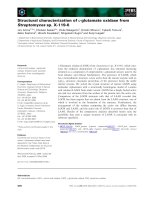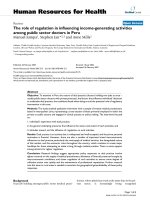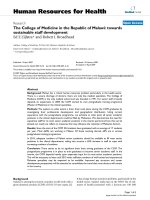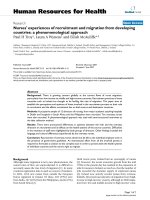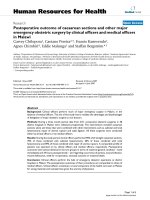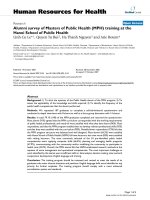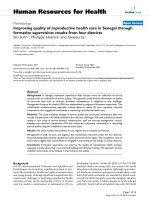báo cáo sinh học:" Nurses'''' experiences of recruitment and migration from developing countries: a phenomenological approach" pdf
Bạn đang xem bản rút gọn của tài liệu. Xem và tải ngay bản đầy đủ của tài liệu tại đây (245.42 KB, 7 trang )
BioMed Central
Page 1 of 7
(page number not for citation purposes)
Human Resources for Health
Open Access
Research
Nurses' experiences of recruitment and migration from developing
countries: a phenomenological approach
Paul H Troy
1
, Laura A Wyness
2
and Eilish McAuliffe*
3
Address:
1
Beaumont Hospital, P.O Box 1297, Beaumont Road, Dublin 9, Ireland,
2
Health Policy and Management, Trinity College Dublin, 3-4
Foster Place, Dublin 2, Ireland and
3
Centre for Global Health, Trinity College Dublin, 3-4 Foster Place, Dublin 2, Ireland
Email: Paul H Troy - ; Laura A Wyness - ; Eilish McAuliffe* -
* Corresponding author
Abstract
Background: There is growing concern globally at the current flows of nurse migration,
particularly from low-income to middle and high-income countries. Recruitment practices of many
countries such as Ireland are thought to be fuelling this rate of migration. This paper aims to
establish the perceptions and opinions of those involved in the recruitment process on their role
in recruitment and the effects recruitment has on both source and destination countries.
Methods: A purposive sample of 12 directors of nursing, from major academic teaching hospitals
in Dublin and hospitals in South Africa and the Philippines were recruited. Ten overseas nurses
were also recruited. A phenomenological approach was used with semi-structured interviews as
the data collection method.
Results: There were pronounced differences in opinions between the Irish and the overseas
directors on recruitment and its effects on the health systems of the source countries. Difficulties
in the retention of staff were highlighted by both groups of directors. Other findings included the
language and cultural differences experienced by the overseas nurses.
Conclusion: Recruitment of overseas nurses should not be left to the individual employer even in
the presence of government guidelines. An international effort from all the involved parties is
required to formulate a solution to this complex issue in order to protect both the health systems
of individual countries and the nurse's right to migrate.
Background
Although nurse migration is not a new phenomenon, the
current rates of flow are unprecedented. It is difficult to
accurately assess the true level of migration [1]. In many
countries registration data is used as a source of statistics.
In 2004, 1018 new nurses from outside the European
Union registered in Ireland. Of these, 603 (59%) were
from India, 267 (26%) from the Philippines, and 46 (5%)
from South Africa [2].
Until recent years, Ireland had an oversupply of nurses
[3]. However, the recent economic growth from the mid
1990s to the present day has resulted in the expansion of
jobs for nurses in Ireland, so much so, that the number of
jobs exceeded the domestic supply of employed nurses
[4]. Ireland now actively recruits nurses from overseas.
Initially, this trend was indicative of migration from 'high-
income to high-income' country, although in 2000 migra-
tion from 'low and middle-income to high income' coun-
Published: 7 June 2007
Human Resources for Health 2007, 5:15 doi:10.1186/1478-4491-5-15
Received: 29 January 2007
Accepted: 7 June 2007
This article is available from: />© 2007 Troy et al; licensee BioMed Central Ltd.
This is an Open Access article distributed under the terms of the Creative Commons Attribution License ( />),
which permits unrestricted use, distribution, and reproduction in any medium, provided the original work is properly cited.
Human Resources for Health 2007, 5:15 />Page 2 of 7
(page number not for citation purposes)
try became increasingly important. This change was due
to the Irish government's international recruitment drive
launched in 2000, following shortages of nursing labour
as a result of under-investment in the Irish nursing work-
force and the export of Irish nursing labour over previous
decades [5]. In 1998, the Commission on Nursing found
that there was a significant shortage of nurses [6]. The
main reasons for this are the change in status of nursing
students from that of employee to supernumerary status,
resulting in a greater demand for registered nurses to cover
duties that might have traditionally been undertaken by
students. The high turnover rates historically associated
with nursing is also contributing to the shortage of nurses.
High-income countries also face an increased demand for
nurses due to the ageing workforce caring for increasing
numbers of elderly people [7], and young women who
have been traditional recruits into the profession, having
more attractive alternative career choices [8].
Historically, nurse migration was mostly opportunistic or
based on individual motivation and contacts [7]. In recent
years, one of the strongest "pull" factors is said to be the
large scale planned international recruitment practices of
high-income countries [9,10].
Guidelines on recruitment have had little impact on the
management of international migration of overseas
nurses [11]. As these guidelines are not mandatory, many
countries have chosen not to follow them and therefore
they only serve to highlight good employment practices
when adhered to.
International organizations such as the World Health
Organization [12], the International Council of Nurses
[13] and the International Labour Office [11] have all
described the driving factors of migration. Other studies
have focused on the economic impact to the source [14]
and host [15] countries. However there is a lack of infor-
mation available on the experiences and perceptions of
overseas nurses and those involved in the recruitment
process. As nurse migration is increasing globally the
effects of such migration on both source and destination
countries will be examined. There has been relatively little
primary research on the issue of international recruitment
and migration of health workers [16]. Research in this
area tends to focus on the underlying factors of migration
and the economic impact to the source countries. Little is
known about the opinions of those involved in the
recruitment process. This paper explores the opinions and
experiences of directors of nursing in both Ireland and the
source countries, as well as the personal experiences and
opinions of the overseas nurses themselves, currently
working in Ireland. The aim of this paper is to establish
the perceptions and opinions of those involved in the
recruitment process on their role and the effects recruit-
ment has on both source and destination countries.
Methods
Qualitative approaches are associated with subjective
descriptions of life experiences, in order to develop a
greater understanding of the issues being considered. The
intention of this study is not to build theory, but to
describe a lived experience; therefore a phenomenological
approach was used. The goal of phenomenological
research is to describe the world as experienced by the par-
ticipants in the study in order to discover the common
meanings and underlying empirical variations of a given
phenomenon [17]. The origins of this approach can be
traced back to the German Philosophers Husserl (1859 –
1939) and Heidegger (1889 – 1976). Heidegger's Phe-
nomenology which has an ontological base was consid-
ered to be more appropriate to this study than Husserlian
Phenomenology, which has an epistemological base [18].
Heidegger's Phenomenology was chosen due to its ability
to focus in depth, on human experiences as they are lived
[19].
Data collection
The participants were purposefully selected, using the
research question as a guide. Nurse shortages were most
pronounced in the three Dublin Academic Teaching Hos-
pitals (DATHs) [20] therefore study participants were
selected from the Irish Directors of nursing (IDNs) and
the senior nurses from these hospitals. Overseas Directors
of nursing (ODNs) were selected from the Philippines
and South Africa as these countries were identified among
the main sources of nurses to Ireland [21]. Numerous
phone calls and emails were made to hospitals in India to
select ODNs, but these were unsuccessful. For practicality,
one DATH was chosen to obtain a sample of overseas
nurses (ONs) i.e. nurses who had migrated from other
countries to Ireland. Of the ten ONs, five were from India
and five from the Philippines. The mean age of the seven
females was 29 years and for the three males was 30 years.
The nurses had been in Ireland for between one and seven
years.
IDNs and senior nurses in Dublin were included if they
were involved in the recruitment process of ONs to work
in Ireland. ODNs were included if their hospital had turn-
over rates attributed to migration of their nurses to high-
income countries. ONs were excluded if they had been in
Ireland for less than one year.
Data were collected through in-depth interviews with the
12 DNs (Directors of Nursing) (six from Irish based teach-
ing hospitals, three from South Africa and three from the
Philippines), and 10 ONs. The interviews lasted between
30 and 60 minutes and were semi-structured as this
Human Resources for Health 2007, 5:15 />Page 3 of 7
(page number not for citation purposes)
acknowledged the methodological preference for "gentle
guidance" rather than "firm control" [22]. The interviews
took place at a venue suitable to the participants, however,
telephone interviews were conducted with the ODNs.
Before the interview started the participants received
information about the aim of the study, data analysis and
confidentiality. They were also reminded they could
refuse to participate in this study without fear of recrimi-
nation and they could withdraw their consent at any stage
during the interview. All interviews were audio taped and
transcribed verbatim. Ethical approval was sought and
obtained from the relevant research ethics committee.
Written permission was obtained from the Director of
Nursing to gain access to nursing staff in the DATH, and
informed consent was obtained from all participants.
Data analysis
A 'bottom up' approach to coding [23] was used. This
involved reading each interview transcript several times,
then analysing the content by trying to see past a quote at
face value. Quotes appearing to contain similar content
were given the same code and each code was further ana-
lysed to find true meanings within their text. Clusters of
themes emerged from these codes. The credibility of the
data obtained was established by 'member validation'.
This involves taking the analysis of the responses back to
the participants (or 'members') to enable them to check or
comment upon the interpretation [24]. The research
should also be reproducible, therefore a 'decision trail' of
the research process was made clear. A second researcher
found similar themes when analysing the transcripts,
indicating good reliability. Confirmability requires the
researcher to show the way in which interpretations have
been arrived at in the study. In this study the findings are
presented in a clear and logical way.
Results
Five main themes were identified: migratory intentions,
the effects of recruitment/migration, workforce diversity,
alternatives to recruitment, and compensation.
Migratory intentions
All ONs stated that their reason for joining nursing was
that it afforded them the opportunity to work abroad.
Many were encouraged by their families to become a
nurse, even if it was not their preferred career choice. The
ODNs expressed concern at being able to train good qual-
ity nurses from individuals lacking the desire to work as a
nurse. One ODN from South Africa stated: " they are not
nurses in their hearts how can we make them nurses?"
The IDNs also acknowledged that nurses traditionally
joined the profession as they saw it as a 'passport to the
world'. All participants expressed strong feelings on the
nurse's right to migrate. Even the ODNs expressed a strong
belief in the nurse's right to migrate despite the negative
effects of this on their health system. They expressed a dif-
ficulty in balancing their beliefs in this right against their
duties in maintaining a service, although they placed no
blame on the nurses: "Why blame the nurse? She must go,
my heart says so. I must give her my blessing, although I
know we are not coping without her, I will not ask her to
stay." (ODN from South Africa).
The migratory intentions of many overseas nurses are
influenced by family factors and the ease at which their
spouse can find work. Without suitable employment, liv-
ing costs and house prices are too high and therefore the
nurse will consider moving. Some nurses stated, quite
ardently, that they intended to return home and nothing
would change their mind: " like the bird migrating, I will
return home of course it is my home." (ON from
India).
Irrespective of the influencing factors, none of the over-
seas nurses expressed an intension of returning to clinical
nursing in their home country. The main reason was the
difficulty of returning to the poorer working conditions in
the hospitals.
Effects of recruitment/migration
The IDNs, senior nurses and ONs all identified positive
effects of recruitment and migration. There was general
agreement that the effect would be of benefit to the ON,
his or her family, and the economy of the source country.
All the ONs stated the benefits of sending their salary
home to support their family, and some mentioned the
personal benefits of the experience, such as being able to
travel and to engage in further studies. Although the
ODNs acknowledged these benefits to the individual
nurses, their concerns on the detrimental effect on nursing
and the health systems in their own country were notice-
able. The nurses that migrate from low and middle-
income countries tend to be experienced and highly
skilled. Ultimately it is the patient that suffers from the
absence of skill. However, the quality of nurses in the
future is of great concern, as this would have disastrous
effects on the health system of the developing country: "I
am left with only novice nurses our experienced ones
go who will teach the novice nurse? Patient complaints
are frequent because our nurses are not efficient." (ODN
from the Philippines).
The nurses who remain in low and middle-income coun-
tries are faced with increased workloads and rising stress
levels. This has lead to increased sick leave and absentee-
ism, further de-motivating the remaining staff. As an indi-
cation of the seriousness of the problem, one ODN from
South Africa, in an attempt to ease the nurses' workload
and stress, asked them to lower their standards so that
Human Resources for Health 2007, 5:15 />Page 4 of 7
(page number not for citation purposes)
they could complete more work in less time. The loss of
skill is felt in all sectors of the health system as nurses
migrate from private, public and rural areas. Frustration
and a sense of helplessness or even hopelessness at the sit-
uation was apparent from the dialogue with the ODNs.
IDNs did not identify this negative effect to the source
country. This thinking is reflected by the ON, who does
not recognize the negative effect of migration on their
home country: "I think there is what you call a brain
drain a lot of nurses are leaving, but we train a lot, at this
stage we are coping." (ON from the Philippines). This
contrasts starkly with the view of an ODN from South
Africa who stated " we are at a level of desperation "
Workforce diversity
As patients in high-income countries are becoming more
diverse, the IDNs welcome the migration of overseas
nurses, believing it to benefit both nurses and patients:
"There is a sharing of learning which ultimately is good
for nurse and patient care." (IDN). The overseas nurses
had contrasting views on working as a nurse in Ireland.
For some they viewed their experience very positively:
" it is so kinda cosmopolitan like working with a lot of
different nationalities. Different cultures can work
together as one and bring their own unique culture into
work it's so positive." (ON, the Philippines). However,
many overseas nurses experienced difficulties with this
multiculturalism, and chose not to integrate into society:
"We cook our own food, live in our own way when I go
outside I do not mingle much with Irish friends." (ON
from India). This created a sense of isolation for some
nurses. The main reason for not integrating into society
appeared to be the desire to retain their culture as they
found it difficult to adapt to the Irish culture (which they
described as being very different from their own culture).
Cultural differences also present many challenges to
IDNs. They all noted that a "sense of responsibility" for
their work was not embedded in the culture of the ONs.
This was seen as a major obstacle to their integration into
the workforce: " it is a culture thing with the lack of
responsibility that the overseas nurses take for accounta-
bility for their practice." (IDN).
ONs felt stressed due to their awareness of this difference
in their practice. The IDNs also expressed concern that this
lack of responsibility could lead to further problems.
Despite making up a significant percentage of the nursing
workforce, overseas nurses occupy very few senior posi-
tions, something that is frustrating for the IDNs: "It took
so much coaxing to get one to apply for the post and she
was so qualified." (IDN).
Another factor of concern to the IDNs was the language
difficulties of overseas nurses. Good communication is
fundamental to the nurse patient relationship. One IDN
stated "its creating difficulties for our patients". The ONs
expressed great difficulties with language and communi-
cation on their arrival, with one nurse from India describ-
ing it as "mental torture" and saying "it is very difficult I
cannot even answer the phone".
Alternatives to recruitment
It is a shared belief that the recruitment of overseas nurses
will continue for the foreseeable future. All the DNs
shared the belief that alternatives to recruitment must be
considered a priority, although currently this is not hap-
pening at a national level. Recommendations from the
DNs included exploring the reasons why there is a large
dependency on overseas nurses and ways of ensuring suf-
ficient production and retention of nurses. The issue of
skillmix within nursing was identified by each DN as a
way of reducing the need for overseas recruitment, and
one they felt was not receiving warranted attention.
Skillmix can be defined as the different combinations of
staff required to provide patient care [25]. The determina-
tion of the DNs in retaining their nurses was strongly
expressed during the interviews. Each outlined their
achievements at the institutional level, for example mak-
ing annual leave and working hours more nurse friendly,
and securing greater funding for nurse education and
study leave. ODNs also eagerly outlined their attempts to
enhance retention, for example creating "nurse of the
month" awards amongst many other initiatives. All the
DNs agreed that institutional measures would only be
effective if remuneration of the nurse is addressed. If
nurses are to be retained they need to be rewarded finan-
cially.
One of the main challenges facing nursing, identified by
all the directors, is its lack of value within the health care
systems. Both IDNs and ODNs acknowledged their dual
role in ensuring that nurses felt valued within nursing, but
also that nursing received its rightful place within the
health system. In contrast, newly recruited ONs identified
the lack of value on nursing in their home countries, but
reported a very positive experience in Ireland.
Compensation
The ODNs had strong feelings on the issues of compensa-
tion. Some suggested they should be compensated for the
loss of nursing manpower and skill. This could be done by
increasing the capacity of nurse training schools, although
the loss of skill already was acknowledged and therefore
there was concern regarding who would teach the nurses.
One ODN stated that action was already being taken to try
to avoid this situation: "We are working towards the clo-
sure of 22 nurse training schools because of the poor qual-
ity." (ODN from the Philippines).
Human Resources for Health 2007, 5:15 />Page 5 of 7
(page number not for citation purposes)
The ODNs all believed that compensation would be most
effective if used to increase the salaries of those nurses
who remain in the source countries, as these nurses are
paying the price of others migrating. The IDNs felt com-
pensation was not warranted as the nurses chose to
migrate, and received equal opportunities to their Irish
counterparts, which they felt was enough compensation.
However, all the DNs were doubtful of the government's
willingness to agree to provide compensation.
Discussion
The Irish and overseas DNs had opposing views on
recruitment. Recruitment of ONs was seen as a necessity
by the IDNs. The ODNs felt the recruitment processes of
western countries were fuelling current nurse migration.
The views of the Directors will continue to differ so long
as they experience very different outcomes from recruit-
ment. However, all directors agreed on the financial ben-
efits of migration. Other benefits identified by the ODNs
were the travel and educational opportunities, which was
why they supported the migration of nurses. The ODNs
showed great concern regarding the 'brain drain' as it is
known to have detrimental effects on the health systems
in sources countries [26]. The WHO has warned that the
loss of skilled health care workers is bringing health care
systems to a "state of collapse" [27]. The ODNs identified
the increased stress and work levels of the nurses who
remained in their country. This is leading even more
nurses to migrate [28,29].
The findings indicate that the nurses had no intention of
returning to nursing in their home country, if they return
home at all. Kingma (2005) [30] described the "myth of
return" as completely untrue, as most nurse migrants set-
tle in countries outside of their own. The thinking by the
IDNs that knowledge gained here will be useful back at
home appears to be unfounded.
The benefits of a diverse workforce were keenly identified
by the IDNs and some ONs. The culture change for many
overseas nurses was difficult to cope with. Many people
can easily identify their own culture by virtue of being
immersed in another, and may be keen to maintain their
identities and cultural values [31]. IDNs reported that the
ONs were reluctant to take responsibility in the workplace
and go forward for senior positions, despite many of them
being more than able for the job. One possible reason for
this was highlighted in a study conducted by McAuliffe et
al. (2002) [32] with 81 ONs recruited to Ireland. When
compared to their Irish counterparts, it was apparent that
overseas nurses were experiencing difficulties assuming
the autonomy and control over their own professional
nursing practice that is common in Irish nursing practice.
These included issues such as care planning and making
nursing care decisions for patients in a system that
required a greater degree of subjectivity. The findings
highlighted that respondents were more familiar with a
system in which nursing care was delivered with "objec-
tive planned interventions" and where interventions were
guided by adherence to policies and procedures. These
findings are consistent with those of Daniel et al. [33] and
Charest [34], who found that ONs work was directed by
endorsements from doctors and their role was compara-
ble to that of the doctor's assistant. The emphasis for
nurses was on carrying out the legitimate orders of the
physician and that nurse autonomy and being in control
of their practice in terms of exercising their own clinical
judgment was not present in their professional values.
Martin et al. [35] have also reported a seemingly more
paternalistic relationship with physicians. It would be
interesting to explore whether this phenomenon occurs in
other countries that nurses migrate to. Another reason
may be that overseas nurses have unequal career opportu-
nities. An in-depth study by Obrey et al. [36] found that
overseas black and minority ethnic nurses working in Eng-
land felt they had unequal opportunities for career
advancement.
Language was identified by the IDNs as being a major
influencing factor in their decision on where to recruit
from. The nurses' training must have been conducted in
English and nurses must have passed an international
English test before a position of employment can be
offered. Although the Directors recognized a problem
with language, they did so only from the patient's perspec-
tive. It is essential that the nurses feel supported through
this difficulty as it may negatively effect their decision to
stay.
Alternatives to recruitment were identified by the IDNs,
although until Ireland supplies enough nurses to meet its
demand, recruitment will continue. This is true for all
Western countries currently experiencing nurse shortages
[37]. Underproduction has been a significant causative
factor of current shortages globally [11]. Skillmix was seen
as a solution to reduce the need for ONs, although both
Irish and overseas DNs encountered difficulties with its
introduction, with the absence of National leadership on
this issue being a main contributor. IDNs stressed the
importance of maintaining a quality learning environ-
ment if student numbers are to be increased. In maintain-
ing a quality environment here, there is continued
reliance on ONs, thus fuelling migration. As well as affect-
ing the quality of the learning environment in source
countries, the quality of the health service in its totality
would be affected. This was not identified by the IDNs. All
Directors identified the lack of value within the health sys-
tem for nursing. ONs however, only identified a lack of
value in nursing in their home countries, and not in Ire-
land. This may present problems with one cohort of
Human Resources for Health 2007, 5:15 />Page 6 of 7
(page number not for citation purposes)
nurses feeling undervalued while another feels the oppo-
site. The ICN warned of the damaging consequences of
placing new recruits into a dysfunctional system [38].
Although the ODNs felt compensation for the loss of their
nurses was a very justified request, it is not a straightfor-
ward solution. Compensation is one of the key recom-
mendations of the Commonwealth Code on overseas
recruitment. However, many countries have refused to
sign up to the code because of the compensation clause.
Limitations
Although phenomenological studies generally have a
small number of participants, including more ODNs from
a wider range of countries may have added breadth to
some of the themes. In particular, as India is a major
source country for recruitment of nurses to Ireland, the
inclusion of ODNs from India would have strengthened
the findings of the study. ONs that were recruited to Ire-
land, but have since left were not included in this study.
Inclusion of these nurses would have helped provide
knowledge of factors influencing their decision to migrate
further or return home.
Practical implications
Proactive effective steps are vital to protect the health sys-
tems of source countries. Improvements in working con-
ditions for nurses in their source countries are needed, as
this study identified increasing stress and work levels of
the nurses. The findings also indicated that the poor work-
ing conditions for nurses in their source countries is likely
to contribute to their lack of desire to return home.
Greater encouragement and support should be provided
to overseas nurses to progress in their career. This could be
provided through improved communication to overseas
nurses regarding training and career opportunities, and
providing an on-going support system for nurses through
regular meetings or discussion groups with management
to discuss progress and other relevant issues. There is a
need for further investigation to identify whether barriers
exist in the workplace preventing ONs seeking promo-
tion. Furthermore, the issue of skillmix in nursing should
be addressed through the creation of a national task force
involving all relevant stakeholders. Language barriers
were identified as an issue for integration of overseas
nurses as well as prerequisites of quality nursing care. A
review of the International English test and its suitability
in assessing proficiency in English speaking for nurses
should be conducted. The Irish government should con-
sider establishing language courses for migrants.
Conclusion
The recruitment and migration of nurses is set to continue
for the foreseeable future. It has brought many benefits to
the Irish healthcare system, the ON and their families.
However, if it continues at the current pace, the healthcare
system of the source countries will be severely damaged.
Action is needed at an international level in order to pro-
tect the health systems of source countries currently relied
on by billions of people. Countries no longer have any
ownership of the healthcare professionals they train. In
our globalised world, nurses have become global public
goods. It is no longer possible for one country to solve the
migration problem. Even bilateral agreements between
countries provide limited control over migration flows. A
solution to this complex problem must involve all rele-
vant stakeholders and a commitment to ensure that the
nurse's right to migrate is preserved while protecting the
collective healthcare needs of the involved population.
Unless this is done, wealthy countries will continue to
have their health systems supported by those countries
whose systems are close to collapse.
Competing interests
The author(s) declare that they have no competing inter-
ests.
Authors' contributions
PHT and EMcA participated in the design and analysis of
the study. PHT conducted the research. All authors con-
tributed to the interpretation of the data. LAW drafted the
paper. All authors contributed to the final manuscript.
Acknowledgements
The authors would like to thank all the participants for giving their time and
thought so freely on this subject. In particular, thanks to the overseas
Directors of nursing who accommodated the telephone interviews out of
work hours. Thanks are also due to the Director of nursing at Beaumont
Hospital for granting access to the overseas nurses there.
References
1. Diallo K: Data on the migration of healthcare workers:
sources, uses and challenges. Bulletin of the World Health Organi-
sation 2004, 82:601-607.
2. An Bord Altranais: Nurse Registration Statistics: 2005. [http://
www.nursingboard.ie/en/statistics.aspx].
3. BuchanJ, Parkin T, Sochaski J: International nurse mobility:
trends and policy implications. Geveva , World Health Organi-
sation; 2003.
4. Aiken LH: Trends in international nurse migration. Health
Affairs 2004, 23(3):69-78.
5. Yeates N: A dialogue with "global care chain" analysis: nurse
migration in the Irish context. Feminist Review 2004, 77:79-95.
6. Commission on Nursing: A blueprint for the future: report of
the commission on nursing. Dublin , Stationary Office; 1998.
7. Buchan J: Nurse migration and international recruitment.
Nursing Inquiry 2001, 8(4):203-204.
8. BuchanJ: Global nursing shortages: are often a symptom of
wider health system or societal ailments. British Medical Journal
2002, 324:751-752.
9. Kingma M: Nursing migration: global treasure hunt or disaster
in the making. Nursing Inquiry 2001, 8:205-212.
10. Bach S: Migration patterns of physicians and nurses: still the
same story. Bulletin of the World Health Organisation 2004,
82(8):624-625.
11. Bach S: International migration of health workers: labour and
social issues. In Working Paper 209 Geneva , International Labour
Office; 2003.
Publish with BioMed Central and every
scientist can read your work free of charge
"BioMed Central will be the most significant development for
disseminating the results of biomedical research in our lifetime."
Sir Paul Nurse, Cancer Research UK
Your research papers will be:
available free of charge to the entire biomedical community
peer reviewed and published immediately upon acceptance
cited in PubMed and archived on PubMed Central
yours — you keep the copyright
Submit your manuscript here:
/>BioMedcentral
Human Resources for Health 2007, 5:15 />Page 7 of 7
(page number not for citation purposes)
12. Buchan J, Perfilieva G: Health worker migration in the Euro-
pean region: country case studies and policy implications.
Copenhagen , WHO Regional Office for Europe; 2006.
13. Buchan J, Calman L: The global shortage of registered nurses:
an overview of issues and actions. Geneva , International Council
of Nurses; 2004.
14. Muula AS, Panulo B, Maseko FC: The financial losses from the
migration of nurses from Malawi. BMC Nursing 2006, 5(9):.
15. Kirigia JM, Gbary AR, Muthuri LK, Nyoni J, Seddoh A: The cost of
health professional' brain drain in Kenya. BMC Health Services
Research 2006, 6(89):.
16. Buchan J, Jobanputra R, Gough P, Hutt R: Internationally recruited
nurses in London: a survey of career paths and plans. Human
Resources for Health 2006, 4(14):.
17. Baker C, Wuest J, Stern PN: Method slurring: the grounded the-
ory/phenomenology example. Journal of Advanced Nursing 1992,
17:1355-1360.
18. Mackey S: Phenomenological nursing research: methodologi-
cal insights derived from Heidegger’s interpretive phenom-
enology. International Journal of Nursing Studies 2004, 42:179-186.
19. Taylor C: Patients’ experiences of ‘feeling on their own’ fol-
lowing a diagnosis of colorectal cancer: a phenomenological
approach. International Journal of Nursing Studies 2001, 38:651-661.
20. McCarthy G, Tyrrell M, Cronin C: National study of turnover in
nursing and midwifery. Dublin , Department of Health and Chil-
dren; 2002.
21. An Bord Altranais: 2006 [
]. Dublin ,
Accessed: 23 Jan 2007
22. Rose K: Unstructured and semi-structured interviewing.
Nurse Researcher 1994, 1(3):23-32.
23. Coffey A, Atkinson P: Making sense of qualitative data: comple-
mentary research strategies. London , Sage Publications; 1996.
24. Smith JA: Evolving issues for qualitative psychology. In Hand-
book of qualitative research methods for psychology and the social sciences
Edited by: Richardson JTE. Derby , Biddles Ltd; 1997.
25. Richardson G, Maynard A: Fewer doctors? more nurses? a
review of the knowledge base of doctor-nurse substitution.
In Centre for Health Economics Discussion Paper 135 York , University
of York ; 1995.
26. Pang T, Lansang M.A, Haines A: Brain drain and health profes-
sional: a global problem needs global solutions. British Medical
Journal 2002, 324:499-500.
27. WHO: World Health Report. Geneva , WHO; 2006.
28. Munjanja O, Kibuka S, Dorlo D: The nursing workforce in sub-
Saharan Africa. In Issue Paper no 7 Geneva , International Council
of Nurses; 2005.
29. Kline D: Push and pull factors in international migration. Jour-
nal of Nursing Scholarship 2003, 35(2):107-111.
30. Kingma M: Nurses on the move: migration and the Global
health care economy. London , Cornell University Press; 2005.
31. Narayanasang A, White E: A review of trans-cultural nursing.
Nurse Education Today 2005, 25:102-111.
32. Mc Auliffe E, Johnston F: The Adaptation of Overseas Nurses to
Irish Culture and the Nursing Practice Environment in an
Irish Hospital. Dublin , Beaumont Hospital; 2002.
33. Daniel P, Chamberlain A, Gordon F: Expectations and experience
of newly recruited Filipino nurses. British Journal of Nursing 2001,
10(4):254-265.
34. Charest CA: Analysis of a transcultural innovation: the social-
isation of Filipino-graduate nurses into an acute health care
organisation in the United States. In Graduate School Volume Doc-
tor of Education . Massachusetts , University of Massachusetts; 1992.
35. Martin K, Wimberly D, O’ Keefe K: Resolving Conflict in a Multi-
cultural Nursing Department. Nursing Management 1994,
25(1):49-51.
36. Obrey A, Vydelingum V, Robbins I: Overseas nurses’ experiences
of equal opportunities in the NHS in England. Journal of Health
Organization and Management 2006, 20(2):130-139.
37. Hancock C: The future of nursing: an international perspec-
tive. Geneva , International Council of Nurses; 2006.
38. International Council of Nurses: Nurse retention, transfer and
migration position statement. Geneva , International Council of
Nurses; 1999.
